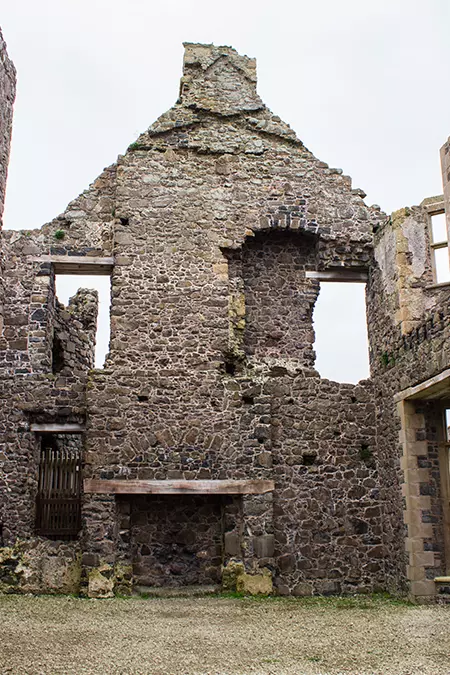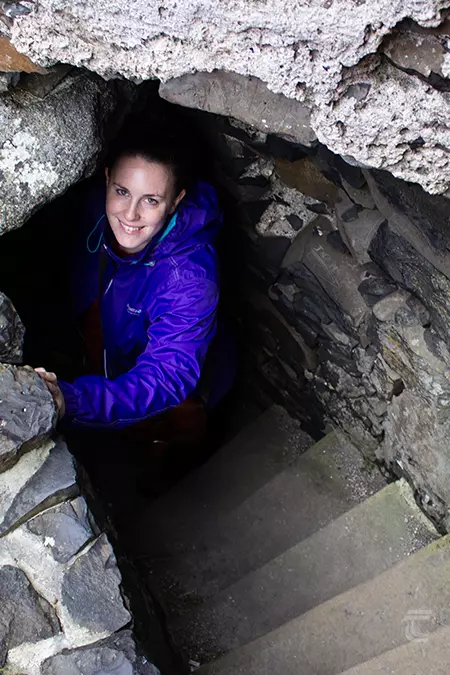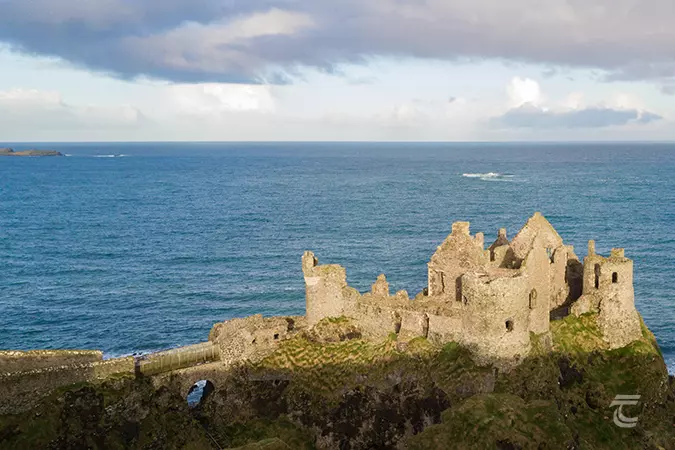Dunluce Castle
Set on a rocky outcrop high above the Atlantic Ocean, Dunluce Castle appears like something from a modern fantasy film. It has also had a long and complex story. Over its history, Dunluce was at one time or another the formidable seat of the de Burgh, Earls of Ulster, the MacQuillan, Lords of the Route, and the MacDonnell, Earls of Antrim. These powerful families helped to shape northern Ulster, particularly during the turbulent times of the 16th and 17th centuries.
Each of them in turn expanded the beautiful castle of Dunluce using wealth gained from the spoils of war, advantageous marriages and Spanish shipwrecks. This wealth also allowed them to construct a modern town and invited Scottish settlers. Dunluce’s inhabitants have become legendary for their fighting, daring recapture of their castle and for their kitchens falling away (more of that below!).
Today the stunning remains of Dunluce can be seen perched 36m (120ft) above the water on the very edge of a basalt cliff. It’s connected to the mainland by a bridge built over a natural 45cm (18in) stone connection and offers commanding views of Scotland and Donegal.
For practical information about visiting this site Click Here

Aerial view of Dunluce Castle and the spectacular Causeway Coast • Antrim
The History of Dunluce Castle
The first castle at Dunluce was said to have been built in the 13th century by Richard de Burgh, Earl of Ulster. Not only was de Burgh one of the most powerful men in Ireland, but he was held in high regard in Scotland too as the father-in-law of King Robert the Bruce. However, nothing of this castle remains today if it did indeed exist. Archaeologist T.E. McNeill contends that the castle cannot have been built prior to 1360, and David Sweetman suggests it may be late 14th century at the earliest. We do know that by the 16th century, Dunluce castle was owned by the MacQuillan family, Lords of the Route. They expanded Dunluce and added to its defences by constructing at least two drum towers, a curtain wall and a gatehouse. The castle then passed to their arch-enemies and great rivals, the MacDonnells. One story states that Dunluce was taken by the MacDonnells after a huge battle, while another tells of how Evelyn MacQuillan was married to Colla MacDonnell, bringing peace to the two opposing families in the area and putting Dunluce Castle into MacDonnell hands. When Colla died, Dunluce passed to his younger brother, the famous Sorley Boy MacDonnell (who is said to be buried at Bonamargy Friary).
While under Sorley Boy’s control, Dunluce castle was captured by John Perrot, Lord Deputy of Ireland, and his men. However, Sorley Boy managed to recapture the castle through ingenious methods in 1584, after only one year of occupation. The tale that is often told describes how Sorley Boy sent one of his men to infiltrate the English garrison. Once he inveigled his way in, his man lowered a basket from a window in the castle down to a boat with Sorley Boy and his men floating below. The poor man then had to haul each of the men up the 120ft cliff into the castle. The unsuspecting English were caught off guard and Dunluce Castle fell back under MacDonnell control.
The MacDonnells left their mark on the castle too. They are said to have used the material and cannons salvaged from the nearby shipwreck of the Spanish Armada’s La Girona, installing the cannons on their Scottish style gatehouse. The rest of the ship’s goods were sold to fund the expansion of the outer ward onto the mainland, as well as the building of a manor house inside the old walls and the planning of formal gardens. In 1608, Randal MacDonnell, the first Earl of Antrim and the son of Sorley Boy MacDonnell, built a planned town near Dunluce Castle. This modern town was ahead of its time with cobbled streets and stone houses. The population who lived in the shadow of Dunluce castle were made up of native Ulster Irish and Scottish settlers, and by 1620 the town had up to 300 inhabitants.

Interior of Dunluce Castle • Antrim
The castle we see today is one of the most dramatic ruins in Ireland. How it went from being the great stronghold for the Earls of Antrim to ruin is told through a popular folktale. The story goes that in 1639 the MacDonnells were hosting a dinner party in Dunluce Castle. There was a terrible storm that night, and the strong winds and crashing sea below caused a chunk of the cliff to give way. This piece of cliff was supporting the kitchen of the castle and guests saw the tables, silverware, the dinner and even nine members of kitchen staff fall into the stormy waters below. A single kitchen boy managed to survive by clinging to the crumbling wall of the castle and was pulled to safety. After this the Lady of Dunluce wished to leave for good and the family moved to Ballymagarry Castle.
Though it makes for a great story, it appears unlikely to be true as the original castle kitchens are still intact to this day. What might have pushed the family to move to Ballygarry is the attack on the town of Dunluce by Irish rebels in 1642 and the castle’s seizure and despoilment by the Scottish General Munro later that same year. Though the settlers tried to rebuild Dunluce town, it never fully recovered and was abandoned by 1680. With the castle and town of destroyed, Dunluce was abandoned until 1928 when it came into state guardianship.
In 2014, excavations began at Dunluce Castle and the town. Archaeologists have found animal bone, coins, glass beads, pottery, clay pipes, a merchants seal and evidence for a variety of metal work. You can read the full story in the publication Dunluce Castle: History and Archaeology by Colin Breen, and published by Four Courts Press.
Upper left: aerial view of the castle • Lower left: the castle viewed from the road • Right: Róisín Burke explores Dunluce
Top: aerial view of the castle • Middle: Róisín Burke explores Dunluce • Bottom: the castle viewed from the road
Explore more sites in Northern Ireland





